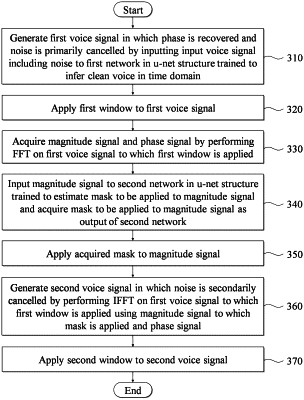| CPC G10L 21/0224 (2013.01) [G06N 3/045 (2023.01); G06N 3/08 (2013.01); G10L 21/0232 (2013.01); G10L 25/30 (2013.01)] | 20 Claims |

|
1. A noise cancellation method using a computer system, the noise cancellation method comprising:
generating a first voice signal by canceling a first portion of noise included in an input voice signal using a first network, the first network being a trained u-net structure, and the first portion of the noise being in a time domain;
applying a first window to the first voice signal to obtain a first windowed voice signal;
performing a fast Fourier transform (FFT) on the first windowed voice signal to acquire a magnitude signal and a phase signal;
acquiring a mask using a second network based on the magnitude signal, the second network being another trained u-net structure;
applying the mask to the magnitude signal to obtain a masked magnitude signal;
generating a second voice signal by canceling a second portion of the noise by performing an inverse fast Fourier transform (IFFT) on the first windowed voice signal based on the masked magnitude signal and the phase signal; and
applying a second window to the second voice signal to obtain a second windowed voice signal.
|